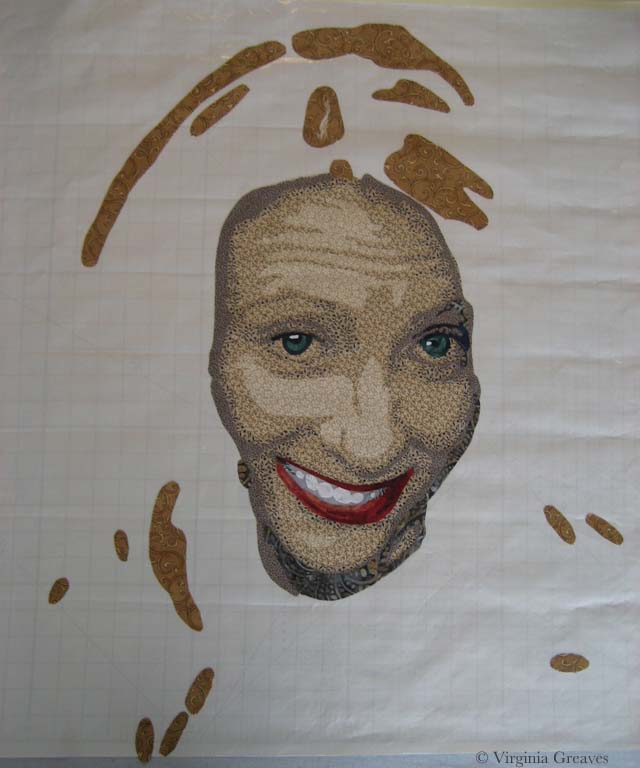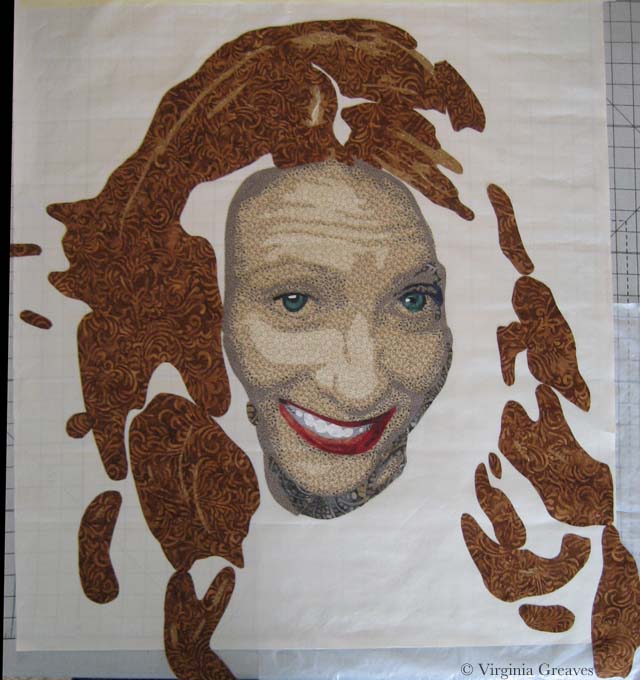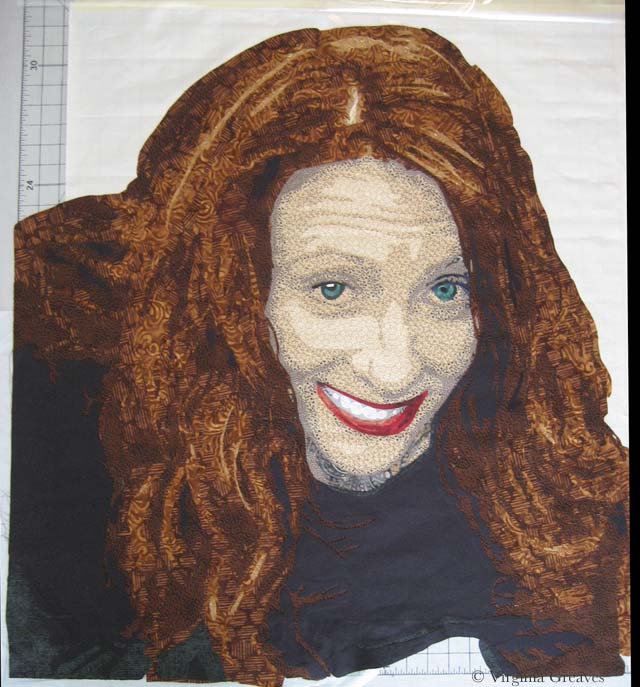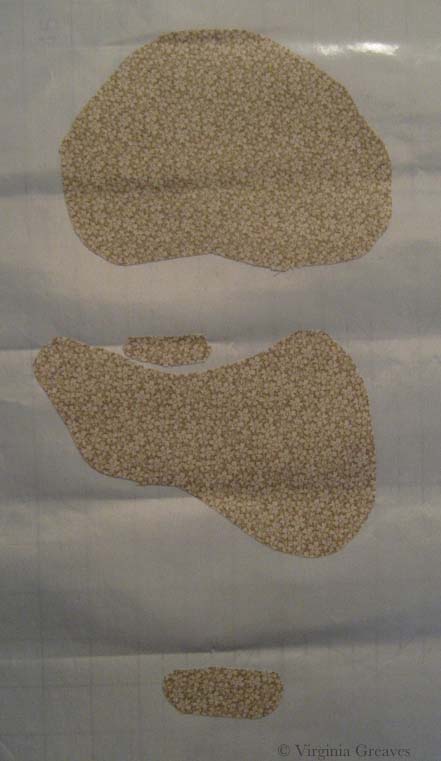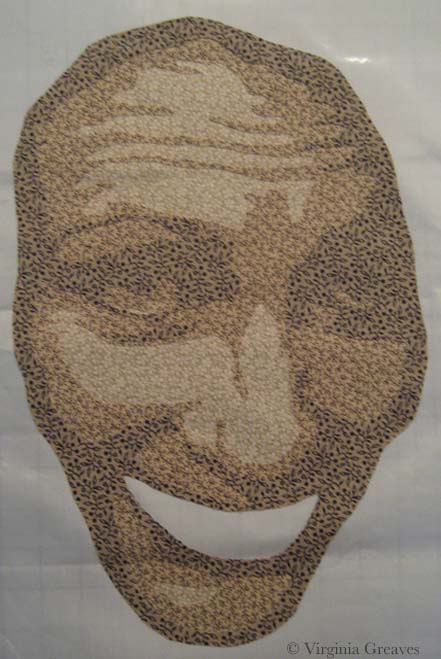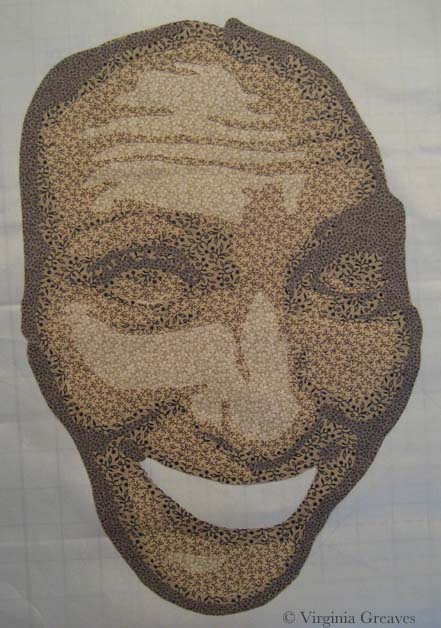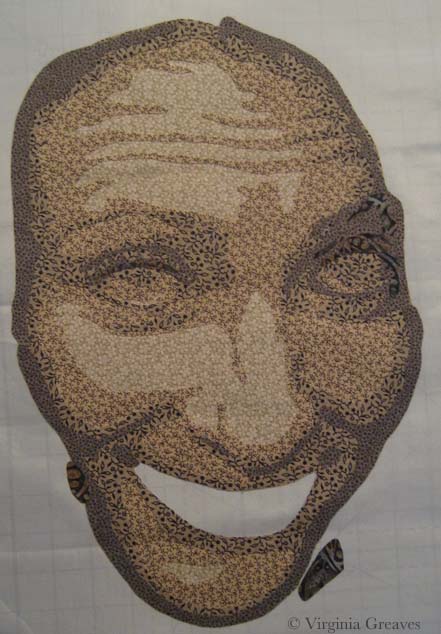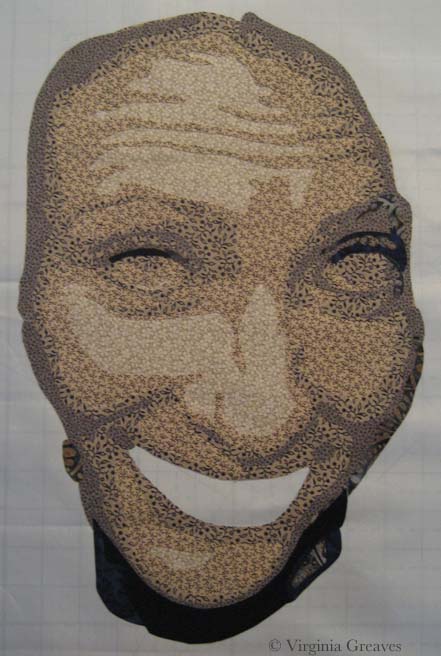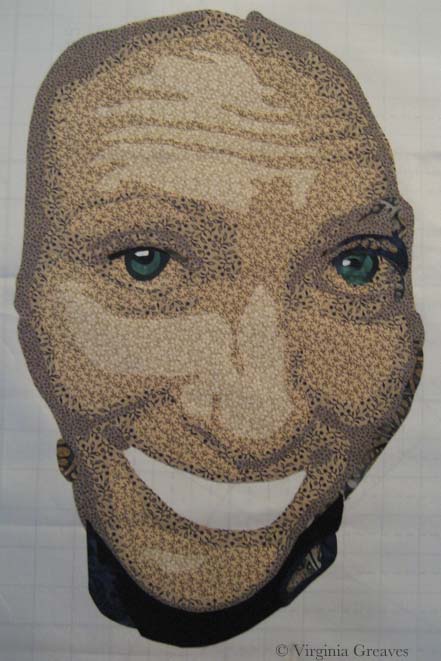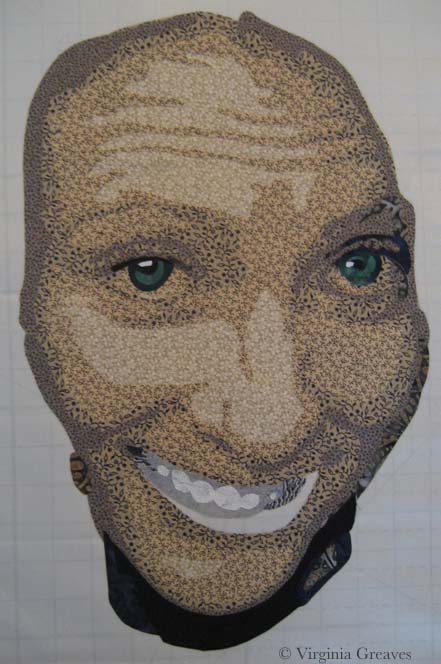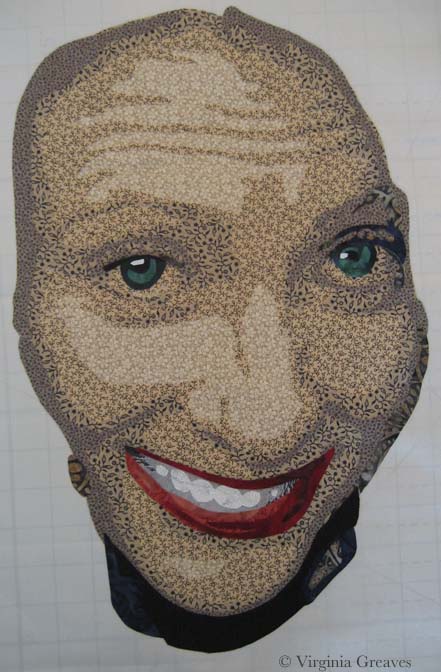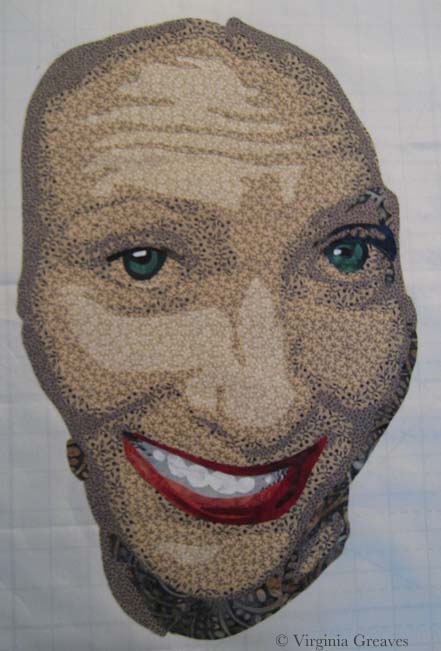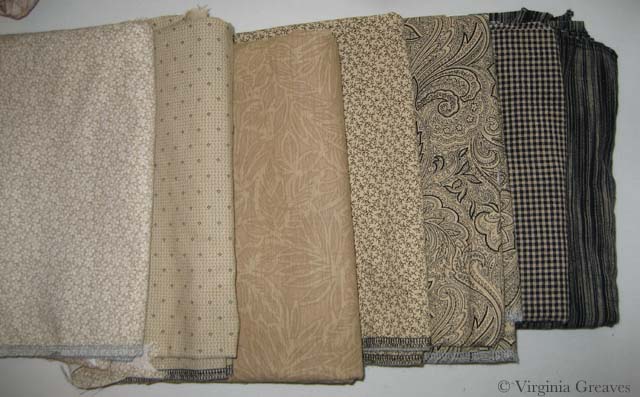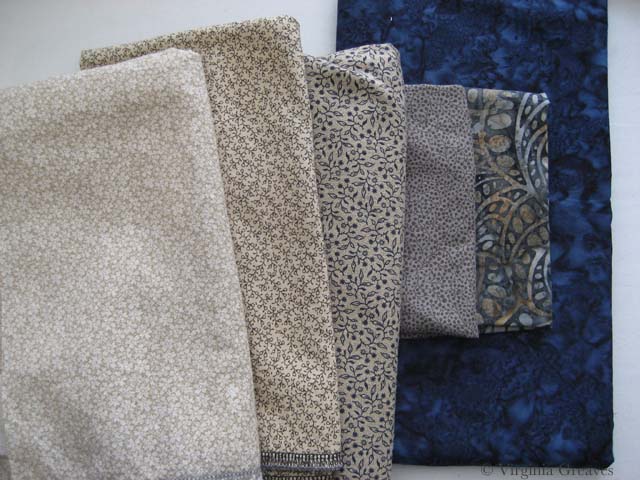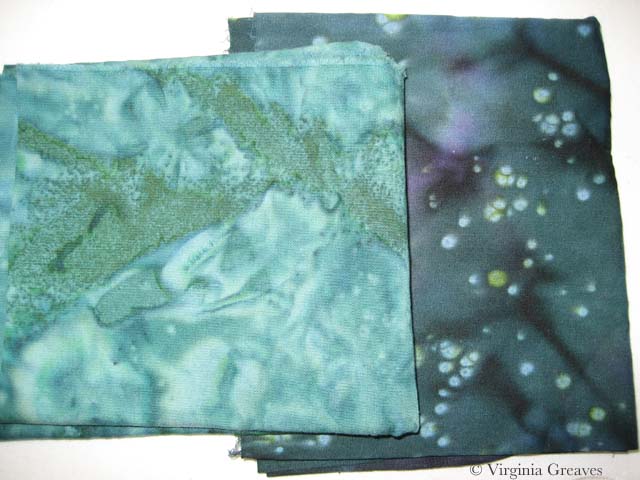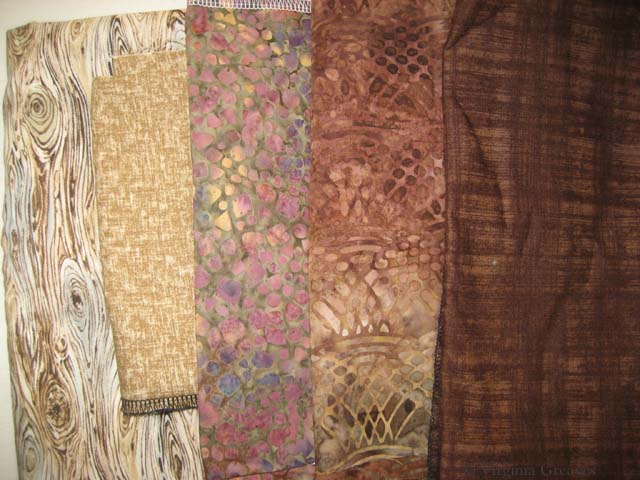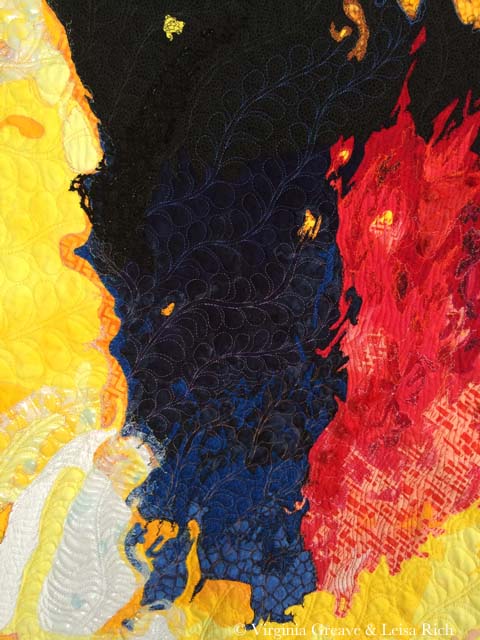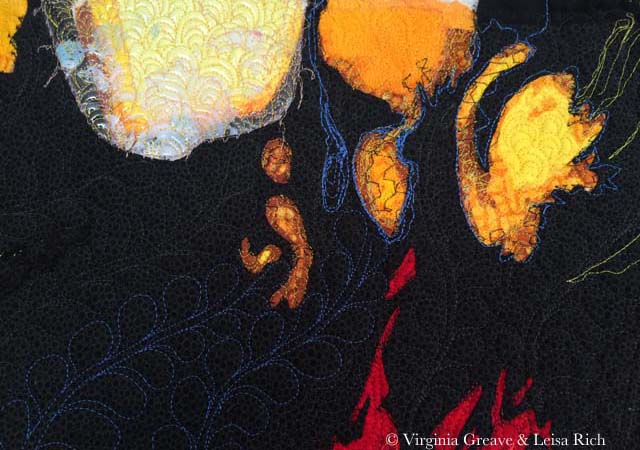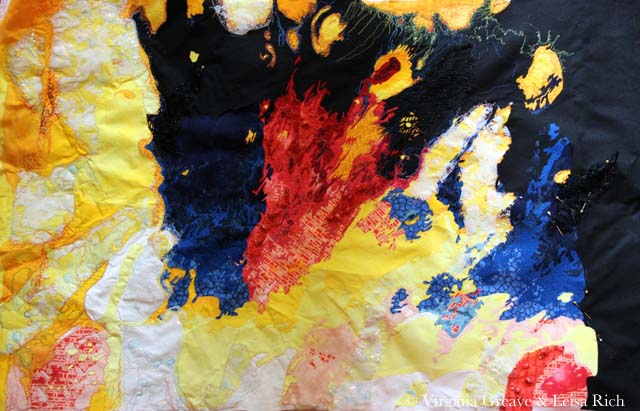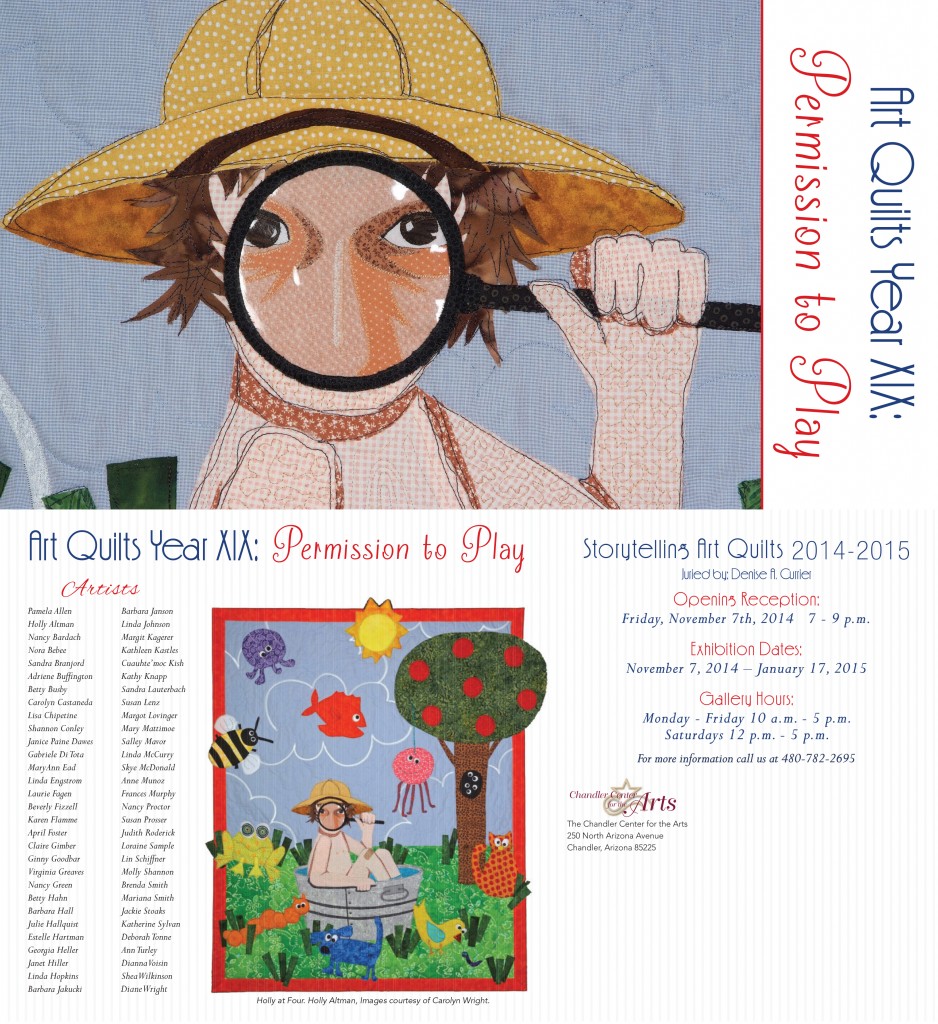Posts tagged textile painting

Looking Forward
3I have been neglecting my blog. Instead, I spent the week briefly looking at the vitriol on QuiltArt, and then turning to my studio. The best thing to combat all of the crushing criticism was a deadline.
Although among all the negativity, I received a lot of surprising support. I had some Atlanta friends that stood in the gap for me when I couldn’t, and for that, I am truly grateful. I also had some internet friends stand up and proclaim their support, and I received many emails of support and encouragement. I heard from people I never expected to, and I made some new friends. So out of the fire, there has been some good.
My last blog post has been read, I believe, almost 2,000 times. People have been combing my website, and I’m certain that a good deal of it was in judgment, not support.
There is something about the Migrant Mother photograph — and my use of it — that brought out a lot of strong emotions in people. And in that regard, I think it has been successful. Not all of the PR has been good, but it’s certainly been a topic of discussion.
Regardless of all of that, I have deadlines to meet. I have an entry due at the end of the month and guests coming next week — so this new piece has to be completed this week. I finished the quilting yesterday and am almost done with the handwork. I hope to complete it today and block it.
And then there are new shows to consider. I have another piece based on a Dorothea Lange photograph that I’m considering entering in AQS — at risk of the ivory tower elitists coming to hunt me down for having the gall to (gasp) use someone else’s photograph as the inspiration for a piece of work. I also have to prepare for Sacred Threads which is coming up as well as the local East Cobb Quilt Guild Show.
Furthermore, all of my studio efforts after finishing my current portrait will go back to the abstract pieces for the two person show I’m debuting with Leisa Rich in October.
One foot in front of the other — moving forward. There are people that don’t like my decisions, but life is too short to spend time worrying about them. They don’t understand me — and I don’t understand them. It’s like the school playground all over again. I think I’ll just go back to my studio. It’s peaceful there.

The Use of Someone Else’s Photograph in Your Work
8Worry has been quite the topic of conversation today. The QuiltArt List (an online email list for quilters) has been abuzz since someone brought up the subject of this piece at IQF-Houston — and not in a good way.
Many people are familiar with Dorothea Lange’s iconic photograph from the Great Depression — titled Migrant Mother — from which this piece is inspired. The original poster thought that I had merely printed the picture onto fabric and then thread painted it — therefore saying that it was a gross violation of Dorothea Lange’s copyright.
Well obviously Dorothea Lange’s photograph is in black and white and this is not. My piece is all machine appliquéd from commercial fabrics. It is NOT a colorized version of her photograph that was printed onto one sheet of fabric.
Also, I am clear that this is inspired by Dorothea Lange’s photograph, and if you look it up, you will find that — however famous the photograph is — it is in the public domain and therefore free of copyrights.
I also assure that there was extensive drawing from the original photograph to create this pattern. I make a value painting of all of my pieces that start from a photograph, but photographs rarely ever tell you everything you need to know. There are many details that photographs don’t tell you — like fingers and eyes — and many shadows have to be deepened and highlights have to be brought out. You can obviously and easily posterize any picture in Photoshop, but these patterns will never have the level of detail for which I strive.
Furthermore, since it’s a black and white photograph, the color story is entirely mine.
You can make an argument regarding composition. I understand that. In using Dorothea Lange’s photograph, I used her composition. I did not violate her copyright nor did I break any of the rules of the competitions in which she has been entered.
It’s a decision. A couple of years ago, I researched how to make my work more marketable. One way to do that is to use historical figures as subjects. This means using someone else’s composition — essentially. I don’t always do this, but sometimes I do.
There are people that don’t agree that this should be viewed as art.
It’s interesting. I only find this discussion among quilters. I hung this piece in an art exhibit back in May. Everyone knows its inspiration is a well-known photograph — and no comment was made about whether or not it was art. It was not brought into question whether or not it was eligible for a ribbon. I am sharing this merely to contrast the differences between the two communities.
Is it art? Have I created something that hearkens back to the story Dorothea Lange created — and yet made it my own, using my own medium? Does anyone see the modern era mother who has the same stress as the mother from the Great Depression about caring for her children in times of economic hardship? I suppose the answer will be a personal one to everyone reading this.

Having a Good Hair Day
0Before I left for Houston, I had made some good progress on the hair in this portrait. I always find it hard to leave in the middle of a project, but I had finished most of the hair.
In this pic, here is only one small part of the first value in the part — in the top at the middle. Then the next value is golden.
Although I really wanted to go with brown purples, I just didn’t have them in my stash and I couldn’t find them in the store nearby, so I ended up going from golden into an orange brown — which is really more of a realistic choice for this model’s actual hair.
The next value shows the brown. (I somehow managed to lose one of the highlights in her right eye — didn’t notice it until her hair was done.)
And this shows the darkest browns.
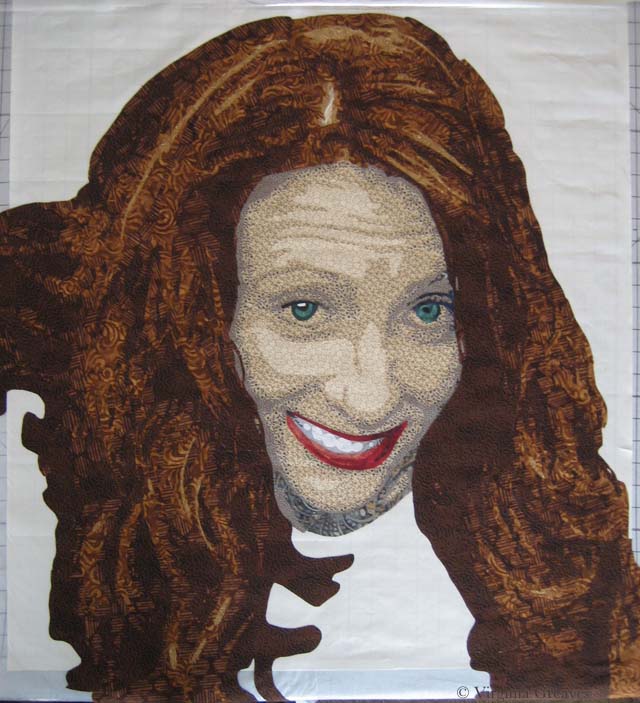
Then I laid in all the blacks, which included her shirt, and the little bit of gray.
I spent of lot time trying to find a perfect background. I had bought several greens, but in the end, they fell flat. A purple seemed like a striking choice, but I didn’t have anything that worked well. I had a blue that I liked, but I’ve used it as a background before, so I went to the store with the mission of finding one similar. This batik has some deeper shadows that I like. It sets her hair off nicely. I took this pic with my iPhone which makes her hair look more red than it is.
I also replaced the highlight in the right eye and put more gray in her right arm. I had it all brown which was just wrong and caused by blurred lines between her hair and her shirt.
This week, I added the background and started the appliqué. Her face is done and I’m about halfway done with her hair. I hope to start quilting her soon. The days are clicking by quickly and my deadline approaches.

Building Character in a Face
3I have been busy cutting away here recently. This is my favorite part — cutting and fusing. It’s meditative and yet the puzzle is still challenging.
I do have to say, however, that my decision to choose different colors has resulted in an even greater sense of realism than I have had before. Because of this, presenting the face in layers feels more odd than ever before. By the time the face is fully shown at the end of this post, without hair, it feels like looking at a naked face. It’s a little unsettling.
I also confess that, after taking several pictures of my model, I chose not to go with one that you would choose to go on your mantle. I think this is a more playful picture that shows her personality better. She’s actually looking up a little at the viewer.
This is the first layer. I’ve learned the hard way not to go any lighter than this.
And this is the second value. I know that my model is screaming at me right now. I promised not to show any wrinkles. The truth is that because she is looking up into the camera, there are lines of personality here. They seem stark in this picture, but bear with me. In the end, especially once all of the hair is fused on, they will only add to her character and will not be seen as age lines.
Here is the third value. It’s always important to remember that eyes are set INTO our faces so even if the picture doesn’t give us darker values around the eyes, it’s best to put it there for our rendering to give a sense of depth.
Here is the fourth value. I was surprised that this stony gray worked so well in this gradation.
This is the sixth value. There isn’t much of it here.
This is the seventh value. It’s actually a deep navy blue.
The eighth value is black which is mostly in the neck. I’ll revisit that in a minute.
These are her lovely green eyes. You can begin to see her peeking out of the fabric.
And these are her teeth. They don’t make a lot of sense yet without her lips. These are the only pieces that I put on in reverse order — dark to light.
And here she is with her mouth. She looks a little stark without her hair — but I’m working on that now.
At this point, I step back and think about how this will work with what I have to do next. Her neck is too dark given that her shirt will be black, so I decide to pull the values back and re-do the neck.
Here they are re-done. You see a lot more of value six, which I prefer, but you still get the sense of the jawline and the recession of the neck.
Hopefully I’ll finish her hair before I leave for Houston next week.

Around the World
0Last year in Houston at Quilt Festival, I had the pleasure of meeting Marilyn Wall. I had admired her work for some time and was excited to meet her. She was attending with an old friend of mine, Denny Webster, who had recently moved from Atlanta to North Carolina.
Marilyn asked me recently if I was interested in participating in the Around the World blog hop. I’ve never done one of these before, but it’s essentially a way for bloggers to promote each other. Marilyn nominated me and another blogger — and I’m supposed to nominate a couple of other bloggers. Hmmmm. Most of the bloggers I know have already participated in this blog hop — and quite frankly, life has been very full around here recently.
BUT — what I CAN do is introduce a few things about me that you might not know.
What quilting/sewing thing am I working on?
If you follow my blog at all, you see what I’m working on. Right now, in my studio, I’ve been cutting out a portrait — I’m working on the hair right now. I’ll blog post about the face later this week. It’s my intention to enter this one in the National Portrait Gallery competition and hope it at least makes it to the semi-finals. Hope springs eternal. And in a little over a week, I’m traveling to Quilt Festival in Houston to step out in the Winner’s Circle and find out what my prize will be. I’m starting to feel butterflies in my stomach.
How does my work differ from others of its genre?
This is an interesting question. I started making representative patterns because I enjoyed the process, and my first series of portraits were all monochromatic color studies. Once I moved to Georgia and no longer had a wet studio, I was forced to begin considering commercial prints in portraits, and in this, I was definitely influenced by Deidre Scherer. I studied how she used patterns to her advantage rather than seeing them as an obstacle. I also studied Charlotte Warr Andersen, although all of her faces were made with solids. In the end, I made what I wanted to make. The norm at the time in fabric portraiture was not detail but rather obscurity — the side of the face or the back of the head, a closed mouth, a limited value range. I challenged myself to do teeth, to suggest the gum line or the tongue, to add the intention of the ear. I also made surprising fabric choices, not shying away from patterns, and learned how to make them work for me.
Why do I write/create what I do?
I create what I do because it makes me happy. It’s challenging, and I enjoy a challenging puzzle. I remember taking a picture of my daughter and making it into a pattern — and I loved to see the light of her eyes shine out at me from the design wall. I loved taking the impossibility of a waving flag and successfully presenting it within the confines of my 2D fabrics and the sculpture of my quilting thread.
How does my writing/creating process work?
Now this is a really long thing for me to answer succinctly. I have a picture for inspiration (usually one that I’ve taken but sometimes one that I’ve asked permission to use) and from that, I make a value painting in Photoshop (which means that I draw all over it because pictures are only the beginning and will never give you everything that you need because they are not as good as the human eye). From that, I make a pattern. From that pattern, I create fabric templates that I collage together (cutting and fusing — this is secretly my most favorite part). I then stitch it all together through raw edge appliqué, and then I quilt it.
That’s my story. I’ve had my website since April 2005 because I have always enjoyed computers and it was a way for me to stay connected when I lived in a small town in Alabama (particularly when I became a stay-at-home mom), and I started the blog in September 2007. I had been a writer in my youth, and I have enjoyed adding writing as an expression of my creative intentions. I have enjoyed my journey — and I’ve enjoyed sharing it with anyone that has cared to read it and follow it here.

Breathing Soul
0I have been considering my portrait for entry into the National Portrait Gallery (NPG) competition. It’s always a challenge, artistically, to reverse engineer something — but it also can create a better opportunity for success.
I’ve been studying the work from last year that reached the finals — and I know that whatever I do, my goal is not realism necessarily. There were certainly pieces in last year’s competition that were realistic — and some that were abstract but clearly representative of the human form. I think the greater question is — what can I do that sets my work apart? I can make a piece that looks like a painting from a distance of a couple of feet — but perhaps the better curatorial choice would be one that best represents the materials being used — which in my case is fabric.
So I spent a few days considering the painting of the man with the quilt pulled up to his chin — but in the end, I decided that that’s a poor place for me to start. I don’t make traditional quilts and I have no interest in calling to mind the traditional pieced quilts that grandmothers have created for years.
And then a friend of mine said something on Facebook that struck me. She said — not in regards to me but in general — she felt that representative work in contemporary art was soulless. Wow. And I went back and looked at the fabrics that I was considering for my next portrait (yes there are some value issues here I had not yet resolved) — and I realized that I was following the formula I knew for creating a realistic portrait — and that it was going to feel soulless and boring.
I have felt for a long time that the soul of a portrait is found in the eyes — or the hands — and that’s true — but it’s not enough — not nearly enough for the piece to stand out and grab the attention of the viewer.
And then I started thinking in terms of color. Color does not have to be as straight forward as I was making it. A strict gradation from beige into black was perfectly acceptable — but was it exciting?
I’ve been considering the work of Vincent van Gogh a lot recently — and his work is largely arresting because he used color theory so successfully. Forget what color the thing you’re representing really is — make it what it needs to be in the piece to make the piece successful.
So I started over. I started with beige again but then I went into blue, ending with a deep midnight blue. My fifth fabric, the blue and brown batik, is a step out — but it transitions the beige into the blue. The fourth fabric was difficult. I ended up finding this clay color in my brown bin. It’s a transitional neutral fabric and it’s the right value so it works.
I usually pick the first color family and then start cutting, but I knew that all of it is in relationship to each other — so I went on to pick the fabrics for the eyes. My model does have green eyes — and for this piece, I think that these two will stand out well.
My goal in the hair is to have purplish brown. This is my starting place. The middle one may be too red — but unfortunately, I can’t make it to the fabric store today. (Someone stole my credit card number yesterday and I am stuck waiting on a new one to be delivered.) I think my stash is not complete enough here and I plan to change a couple of these with new fabrics soon — but this gives you an idea of where I’m headed.
I have a beautiful mottled green I’ll probably use in the background.
My goal is to create an analogous color harmony — to use what I know about color to breathe soul into her — to make her come alive in cloth — for her spirit to become apparent in the image. Let’s hope that my bold choices in fabric will help me achieve that goal.
As to whether it will be enough to be juried into the NPG — who knows? But hopefully it will help move me further along in my artistic journey.

More Pics Please!
0A friend told me that it was hard to see what I had done on the piece from my last blog post so I have posted some more detail pics. I hope this makes it easier to see the quilting.

Quilting as Another Dimension
1Yesterday I finally finished quilting the 3rd abstract piece that I’ve been working on collaboratively with Leisa Rich. I have to admit that I let my mind run away with this one.
This is a pic that Leisa took of it after she had added embroidery.
And this is the same piece after I have quilted it.
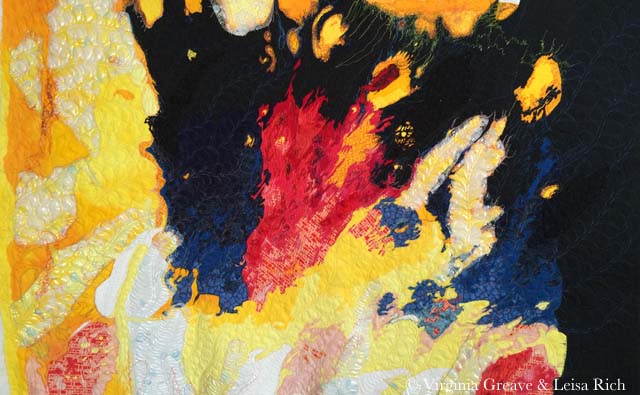
I started with free motion quilted feathers — in metallic thread. CRAZY if you’ve ever sewn with metallic copper thread — but I had the wind at my back that day and it flowed like water onto the surface of the piece. I graduated through copper, purple, blue, and then a gray for the deepest part of the black fabric. I then moved over to the red and brought a flame stitch out of my bag of tricks. Then I moved down into the yellows and whites. I did change to more of a wavy frond for the white — I liked the difference in texture — and some of the yellow blobs were awarded with scallops. I did revisit the copper thread on the lighter blue fabric over on the right hand side — but I was not lucky on those days and struggled with a lot of broken thread. I moved back into blue thread as soon as the piece was ready for a change.
I love free motion quilting on my Janome. Even sewing on the plastic overlay didn’t cause many problems. My Viking would have given me fits.
I hope Leisa forgives me for putting traditional feathers all over it. It called out for that organic feeling. I’ve never used so many free flowing feathers on a piece in my life. It felt good to step out of contour quilting.
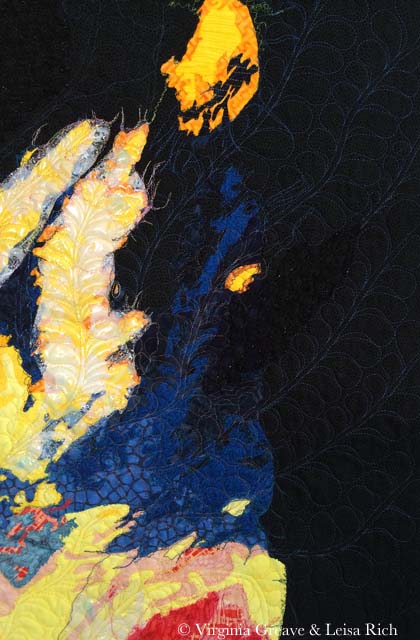 I am giving this back to Leisa next week — I think she’s planning some hand embellishment.
I am giving this back to Leisa next week — I think she’s planning some hand embellishment.
We have a curator that approached a local Atlanta gallery about having a two person show of our work — and it looks like we have reached an agreement and the show will go on in late 2015. Time to get busy — I have a lot to do to get ready!

Opportunities
1I have been quilting the third abstract in the car wash series — having fun with it. I eschewed my usual contour quilting for feathers, flames, & fronds. I love the way it’s turning out. I’m also using the thread to pull colors across applique boundaries — and playing with thread choices. I even coaxed a metallic thread to free motion into feathers.
But I only worked in the studio a couple of days this week. I have a friend that’s been giving me scoping work. I hope to get back in the studio tomorrow.
I would like to say that I’ve been working on another portrait for the National Portrait Gallery competition — but inspiration hasn’t struck. Right now I am in the flow with abstract and I have not been successful in changing my direction.
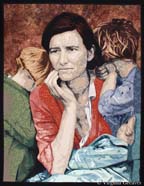 If you read my Facebook Page, you saw me hyperventilating when I was notified that I won a ribbon in Houston again this year. It’s such a huge honor & completely unexpected. I won’t know till the ceremony at the end of October what the prize is exactly. I’m lucky that I’ll get to go to Houston again this year and actually stand in the Winners Circle.
If you read my Facebook Page, you saw me hyperventilating when I was notified that I won a ribbon in Houston again this year. It’s such a huge honor & completely unexpected. I won’t know till the ceremony at the end of October what the prize is exactly. I’m lucky that I’ll get to go to Houston again this year and actually stand in the Winners Circle.
I may even tweet the whole event like I did last year. It was such an exciting time and I loved sharing it.
For those interested in attending, Preview Night for IQF/Houston is October 30. The show is at the George R. Brown Convention Center and runs through November 2.
I did, in fact, come home after winning a ribbon with Lincoln last year and decided — after making animal portraits for a year — that I would make a person portrait again. Worry was the piece that I made from that decision.
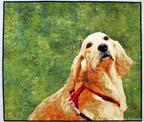 I also found at that Golden Moment was accepted into Art Quilts XIX: Permission to Play. This exhibit is at the Chandler Center for the Arts in Chandler, AZ and will show November 7, 2014 – January 17, 2015.
I also found at that Golden Moment was accepted into Art Quilts XIX: Permission to Play. This exhibit is at the Chandler Center for the Arts in Chandler, AZ and will show November 7, 2014 – January 17, 2015.

Collaboration
0Yesterday I met with Leisa. She still has plans for the small piece we did first so I didn’t get it back — but I took her the larger abstract piece that is second in the series — now that it’s quilted — and she liked it! I thought she would want to embellish it but she made an excellent point about restraint and knowing when to stop. We are both happy with it as it is — so I will add a binding and sleeve and consider it done.
I’m strangely drawn to the thought of an almost completely machine stitched binding. I’ve only done this one other time but it seems apropos to the piece — and has the plus of eliminating a large part of the hand sewing.
I have finished drafting a third piece — I picked out fabrics today — and Leisa and I talked about a fourth piece which will be a whole cloth that we will cut into strips and otherwise playfully manipulate. I have learned so much in this collaboration.
I really didn’t know how to work in groups until graduate school — and I was really forced to do it there. We each gave our best to create the best collective effort. Now it’s easy — with the right people that know how to do it too. People with control issues don’t work well in collaborations. It has to be a give and take. You don’t always get your way but you learn from the other person and respect their opinion. You don’t worry about getting your way — you work on finding a solution that works for both of you. It’s a beautiful theory — it’s a shame that governments don’t work this way.

